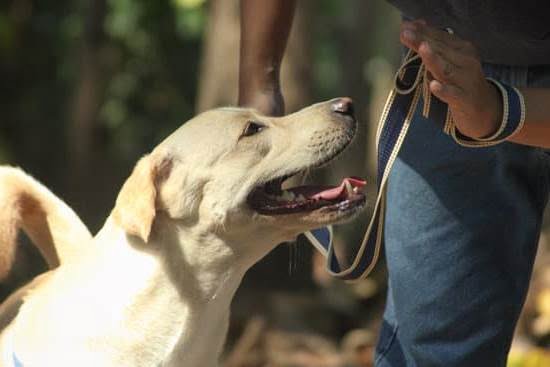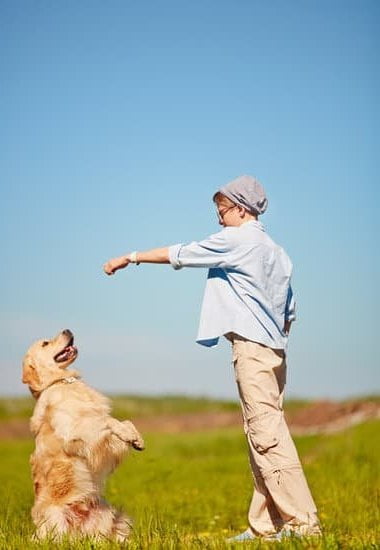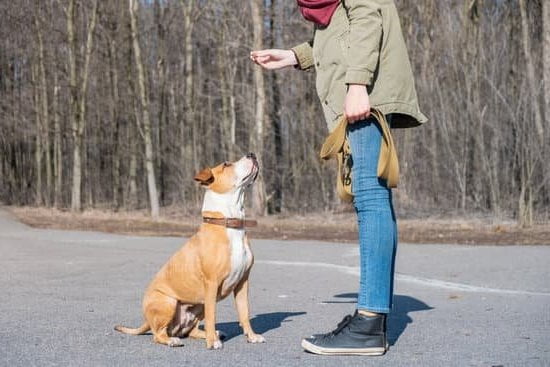Introduction
Training your dog has many benefits. Not only does it help you build a deeper bond with your pet, but it also allows you to create a more structured environment for them and helps them adapt better to their new home. Specifically, dog training can benefit your pet by teaching them how to properly respond to commands and behaviors, enabling them to learn basic manners,and aiding in housebreaking. All of these skills and lessons can be extremely useful for both you and your canine companion.
One of the most important aspects of training your dog is establishing yourself as the pack leader. When you train your dog, they learn that you are the source of their comfort, safety and rewards; this encourages respect and obedience. This makes it easier for you to communicate with them and be clear about what behavior is expected from them. Additionally, when a canine feels secure in knowing that its owner is in charge, they are more likely to feel content and behave correctly out of respect rather than intimidation or fear.
When teaching your pup behavioral etiquette, it’s important to reward positive behaviors whenever possible – this will help reinforce positive behaviors rather than punishing bad behavior. The best way to do this is by using treats as rewards for correct actions that have been performed – such as sitting down – instead of punishing incorrect actions. This not only teaches them proper behavior but also encourages trust between pup and owner since they quickly understand the correlation between the reward and demonstrated action.
Furthermore, consistent training allows you to control disturbances from aggressive animals or difficult situations without having to resort to physical violence; instead of aggressively striking out at other dogs or humans (or being overly protective), well-trained dogs are able to maintain calm composure due to enhanced communication skills with their owners. By setting ground rules early on through routine training sessions, these canine companions understand expectations within boundaries so they don’t make their own decisions based off instinctual reactions which could be detrimental in certain settings or surroundings.
Ultimately, training gives dogs the ability lead calmer lives while providing an acceptable outlet for obedience-seeking habits that all dogs naturally possess; it enables harmonious energy exchange between humans and animals while simultaneously building trust between one another as partners in crime (or companionship). Ultimately, training helps establish a level of comfort within any given environment or situation – regardless if its a walk around town or simply staying home playing fetch!
Understanding Your Dog’s Behaviour
Training your dog is important to ensure that it has a good relationship with other animals and humans. Training helps you understand why your pet behaves the way it does and helps you develop a better bond with them. Training your dog can also help protect them from harm by teaching them basic obedience commands such as sit, stay, come, and down. By teaching these commands, you will be able to keep them under control if they become excited or aggressive towards another animal or person. Dogs who are well-trained may also be more confident and happy because they know how to interact with their environment in an appropriate manner. This can reduce aggression from both parties and make for a safer environment for everyone involved. Training can also reinforce positive behaviors so that misbehaving or disobedience becomes less likely. With repetition and patience, your dog will learn these new skills quickly and readily follow what is expected of them. Ultimately, training your dog is an important part of owning one as it creates a harmonious relationship between the two of you.
The Basics of Training Your Dog
Training your dog is an incredibly important part of being a responsible pet owner. Not only does training help to create a strong bond between you and your dog, but it also ensures that your dog follows commands, behaves in public places and stays safe. Before beginning any type of training, it is essential for the pet owner to understand the basics of dog behavior and training principles.
The first principle when it comes to training a dog is consistency. Dogs learn by repetition and regular reinforcement; if rules are inconsistently enforced or if a reward isn’t given each time the desired behavior is seen, the desired result will not be achieved. It is also important to keep in mind that every command should have only one meaning, such as consistently using ‘sit’ for sitting down, instead of sometimes saying sit and other times commanding them to “stay”.
Another important part of training dogs is setting achievable goals according to their age, breed and personality. Complex tasks should be broken down into smaller steps which will make them easier for the pet to understand and complete. Rewards should always be given after the successful completion of each task in order to motivate them further. Moreover, positive reinforcement techniques such as verbal cues and treats are much more effective than punishment as dogs may become scared or aggressive from physical punishment or reprimands that lead to confusion rather than learning. Lastly, it takes patience and time for a pet owner to raise a well-behaved canine so patience should be practiced throughout the process!
Tips and Techniques to Help with Training Your Dog
Training your dog is an important step in ensuring they live a happy and healthy life. Some of the main benefits of training your dog include creating a sense of responsibility, teaching them essential behaviour skills and commands, developing better communication between you and your pet, and building a strong bond between you and your pup.
To ensure that the process of training your dog is successful, there are some tips to remember. First and foremost, remain consistent in expectations for behaviour – it’s important to be clear and reinforce good behaviour frequently with positive reinforcement. Secondly, establish boundaries early on and stick to them – outlining the rules from the beginning will give the pup structure and let him/her know what behaviours are expected and what needs to be avoided. Lastly, stay patient! Training your dog is a process that will take time for them to truly understand so provide plenty of praise when necessary but also be prepared for times when progress may seem slow or stagnant.
In terms of specific techniques for training your dog, there are lots of methods available depending on what works best for both you and your pup. Positive reinforcement-based approaches such as clicker training are popular as pups typically respond strongly to this type of feedback coupled with treats as rewards (make sure ingredients check out before using!). Behavioural-modification methods like desensitization can be beneficial if particular issues have been identified early on in the pup’s life while some trainers recommend basic obedience lessons like sit/stay/come. Lastly, one-on-one personal coaching can be incredibly useful if you require more individualized attention during training sessions as it tends to allow more tailored advice based on the specific goals being defined by both pet parent as well as pup!
Potential Challenges to Overcome When Training Your Dog
Training your dog is beneficial in many ways. It establishes a good relationship between the dog and the handler, and provides structure to the pet’s life. Training classes can be a great way to spend quality time with your pet while learning valuable skills together. Consistent commands make it easier for your pup to understand what you expect of them.
However, training a dog isn’t always easy and there are some challenges that may arise during the process. The most common challenge is consistency – if one person gives a command in one way and another person gives a different version of the same command, it can lead to confusion for your pup. A lack of results may also be disheartening for handlers as progress will not happen overnight and patience is essential. Unfamiliar distractions such as other animals or loud noises can cause your dog to become distracted easily, making it difficult for them to focus on their training without proper desensitization exercises first. A wide variety of breeds may cause difficulty due to physical limitations like size or hearing range which will require specialized equipment or approaches to accommodate those needs. Finally, temperament issues like aggression or fear should be handled carefully as these challenging behaviors often require advanced methods that are best left up to experienced professionals.
Unique Training Strategies for Dogs with Different Temperaments
Training your dog is important for establishing healthy behavior and a strong connection between you and your pet. However, unique training strategies may be necessary depending on the temperament of the dog. For example, more active breeds like Border Collies need plenty of exercise to help them focus during instruction. Conversely, Toy Poodles may require slower paced exercises that are broken up into smaller increments to prevent them from becoming overwhelmed or too tired.
In addition to adjusting instruction based on a breed’s temperament, it is important to be responsive and consistent when dealing with dogs who have conflicting personalities. A dog might actually seek out attention and praise from human contact but react skittishly when approached by strangers or loud noises. An effective way to curb this dual behavior is to use reward-based systems that provide incentives for good behaviour when near others or exposed to loud sounds. Furthermore, addressing problem behavior quickly and calmly is critical in making sure a pet does not become anxious or disobedient. With patience and understanding, any owner can create a tailored approach that works for their pet’s behaviors without causing fear or confusion.
Preparing for Training and Creating a Positive Training Environment
It is important to consider what you need from the training before actually starting. Deciding on a desired behavior or specific goals for your dog can help build up motivation. Setting realistic expectations and goals is crucial, as too much frustration or unreachable expectations can lead to anger and ultimately failure of the training process. You should also prepare a potential training space for your dog in an area which limits distractions, making it easier for them to focus.
Before beginning training, make sure to establish an environment conducive to learning where both you and your pup feel relaxed and safe. The use of positive reinforcement such as verbal praise, treats and toys can help create a positive atmosphere, while withholding negative feedback will make the experience more pleasurable. Involving family members in the process may also be beneficial as their involvement may help create consistency in their messages and techniques used when interacting with your pup. Your pup’s state of mind should always be taken into account during the training session – providing breaks when needed and rewarding good behavior will help make training enjoyable for both you and your dog.
Using Positive Reinforcement and Appropriate Rewards
Training a dog using positive reinforcement and appropriate rewards is an effective and fun way to teach your pet important skills that will serve them throughout their lifetime. Unlike punishment-based methods, positive reinforcement focuses on rewarding desired behaviors rather than punishing undesired ones. This motivates the dog to perform desired actions without the use of negative stimuli or physical reprimands. Doing so encourages communication between you and your pet, builds trust, and strengthens the bond between the two of you.
Positive reinforcement reinforces desirable behaviors while also avoiding inadvertently teaching negative behaviors due to punishment-based methods or powerful emotional reactions that can be intimidating or frightening for dogs. With this method, rewards should be immediate upon completion of the commanded task as well as consistent in size, type and frequency given. An example could include giving treats for a proper command execution like sitting or staying, lavish verbal praise for coming when called and a favorite toy for successful completion of more complex tasks such as retrieving an object from outside playtime sessions.
In addition to providing an improved relationship with your pet, training your dog with positive reinforcement helps boost their self-esteem and overall wellbeing. By continuously rewarding good behavior, you can create a calm atmosphere where your dog can learn new commands over time which will lead to better obedience resulting in safer walks outdoors and more enjoyable social experiences with other people or other pets. Ultimately, it’s never too late to start training your furry family member – so change paths today!
Premier Training Tools & Equipment
Training your dog is an important part of building a strong bond with them, ensuring safe and respectful interactions between you and your pup. Training also helps to better understand what is expected of them as well as providing physical and mental stimulation. Dogs of any age can benefit from training; puppies will adapt quickly in their new environment with the help of positive reinforcement from you, while older dogs are very eager to learn and understand when corrected.
One way to make sure your training sessions are successful is by using the right equipment. With the use of quality premier training tools like clickers, treat pouches, agility jumping sets, long lines, and even whistles you’re able to maximize teaching opportunities for both you and your dog. Each tool has its own special uses for encouraging desirable behaviour such as following commands or honing specific skills. Utilizing the right kind of equipment that fits the needs of each individual dog breeds leads to faster results and makes learning more enjoyable for both you and your pup.
Tailoring Your Training to Your Dog’s Needs
One of the most important things to keep in mind when training your dog is to tailor it to their individual needs. Every dog is different, and they all have different abilities and tendencies that should be taken into consideration when exploring various training styles. It is also important to assess each unique situation in order to decide on the best training approach for both you and your pet. This could mean taking into account their age, personality, energy level, as well as any existing behavioral issues that need to be addressed.
By assessing your dog’s individual characteristics, you can establish a routine tailored specifically for them and ensure that the relationship between you and your pup stays strong. This type of customized approach will also help increase success rates; you are more likely to be successful if you understand your canine companion’s individuals needs. Additionally being conscious of creating positive reinforcement throughout the process by encouraging desired behaviors and redirecting undesired ones with rewards instead of punishment will make the process smoother for all involved. With this in mind, there are numerous benefits associated with establishing good behavior through gentle guidance and tailor-made exercises such as enhanced communication between both species, improved trust levels over time, better obedience control and a greater sense of companionship between you and your furry friend. All these combined make up why it’s important to train your dog according to their needs; it will not only strengthen ties between bond but it will help set the tone for many happy years together!
Addressing Behavioural Problems When Training Your Dog
When training your dog, it is essential to attend to behavioural problems. The earlier you begin working to address these issues, the better results you will have in creating a harmonious and respectful relationship with your pet. Some of the most common behaviour problems in dogs include aggression, excessive barking, running away, chewing and digging.
One way to tackle these problem behaviours is by understanding what triggers them. Knowing the cause behind your dog’s particular behavioural issue can help you develop strategies to avoid and manage it more effectively. For instance, if your dog tends to bark excessively when visitors come over, then you could train him to stay quiet by rewarding him for being calm and gently reprimanding him for engaging in his problem behaviour.
In addition to understanding causes and developing strategies to deal with specific behaviours, basic obedience training can also help curb unwanted actions from your pup. Teaching your dog commands such as ‘sit’ and ‘stay’ can prove useful for curbing aggression or running away tendencies in your pet. As well as helping mitigate these problems these commands are also beneficial for improving communication between yourself and the animal which can ultimately result in a much stronger bond between you two.
Conclusion
Training your dog is a beneficial and rewarding endeavour that can bring tremendous joy to you and your canine companion. It allows you to establish a healthy bond with your pet and strengthen the connection between you. Training strengthens communication, increases physical and mental stimulation, builds obedience skills, encourages positive behaviour and reinforces good habits. There are some tangible benefits too — training can help prevent problem behaviours from developing and make it easier for you to take your pup to places such as the park or challenges like travel. Additionally, first aid courses such as CPR will provide additional peace of mind in case of an emergency. A well-trained pup can open up many possibilities otherwise unavailable due to safety concerns or private policies. Ultimately, having a well mannered dog also brings great pleasure in knowing they are equipped with the necessary tools to learn new commands, understand boundaries and fit into any environment smoothly which adds even more joy to your life with them!

Welcome to the blog! I am a professional dog trainer and have been working with dogs for many years. In this blog, I will be discussing various topics related to dog training, including tips, tricks, and advice. I hope you find this information helpful and informative. Thanks for reading!





